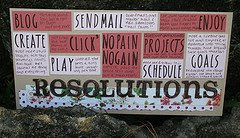
Ah, a new year! A clean slate. A fresh start. An opportunity to set personal, professional and organizational goals to work toward the coming twelve months. I'll leave the personal and professional goal-setting up to you, but I would like to get you thinking about tackling some basic activities that are guaranteed -- yes, I said guaranteed -- to strengthen your organization and renew your commitment to your mission.
Here's my top 10 list of organizational resolutions for 2009:
1. Review your mission out loud at a board meeting or members' meeting. Get some discussion going about what your mission means (or is supposed to mean). Does your activity reflect and support your mission? If it doesn't what do you need to change to bring mission and practice into alignment?
2. Undertake a formal self-assessment of your organization's strengths and weaknesses. This exercise is an excellent springboard for discussions about organizational focus, mission, and practice. If you do nothing more this year than an assessment, you will have created a "to do" list for board, committees, staff and volunteers that could become the basis for organizational activity for a year or more.
3. Review and update your Bylaws. For a lot of boards and staffs, updating Bylaws is a nuisance, yet this document is the fundamental procedural manual by which your organization operates. If your organization is not complying with its Bylaws, you've got to figure out why and then remedy the situation. The remedy may be that you'll be more mindful of following your procedures, or it may be that some procedures may need to be revised or removed. In either case, it's time to align organizational activity to your stated legal documents.
4. Write and approve a code of ethics. A code of ethics can be a stand-alone statement or it can be included in the Bylaws and in other operational policies. Codes of ethics set out procedures for dealing with how an organization maintains the public trust by addressing governing authority (i.e., conflict of interest, relationships with staff and/or volunteers, and working relationships among trustees); collections (i.e., donor relationships, level of collection care and access, deaccessioning); and program.
5. Spend a board meeting becoming financial literate. Talk about the strengths and weaknesses of the current financial information you receive. Provide a basic primer on reading and understanding financial statements, including budgets and audits. What types of financial information do you need that you don't have now? What criteria would be important to identify as a means of evaluating the effectiveness of fundraising and financial management? Do you need to create a multi-year financial plan or contingency plans? Who could help you accomplish something like that?
6. Take a tour of collection storage. Are storage areas secure? Are they clean and tidy? Can you easily get to items stored there? If stored collections are in attics, basements, porches or unheated outbuildings, how are you making those environments better for the long-term care and protection of those collections? Are you meeting your public trust obligations of care?
7. Gather the board and staff to make a top-to-bottom inspection of your institution. That's right -- attic to basement; outbuildings and off-site storage. Everyone needs to know the extent of the physical plan, as well as its strengths, weaknesses, shortcomings, and potential. Once a year, everyone needs to tour the plant. Bring along a camera, too -- photos and videos will help everyone remember what they've seen. Then, when the staff and/or committees in charge of the plant report on its status, you'll have a better understanding of what it is, where it is, and its impact on the organization.
8. Get comfortable with change. Appreciate that a flexible organization is better able to respond to the uncertainties of funding, changing demographics, the demands of audiences and the increasingly watchful eye of government. To keep your organization mentally flexible, plan for the future using a variety of scenarios designed to keep you on your toes!
9. Throw an appreciation party for all the folks who make your organization work (paid, unpaid; top dog and unsung hero). This is the time to share the history, the joy and the sorrows of the organization. It is these stories that cement people to the mission, the place, and to each other. Use this opportunity to build community.
10. Have fun. Laugh a lot -- we're all going to need more than a fair share of humor. Encourage and enjoy the common purpose that has brought you all together. Gracefully bow out if it's no longer fun for you.
Photo: Resolution Layout by { Kathy Marie Perez }


Comments